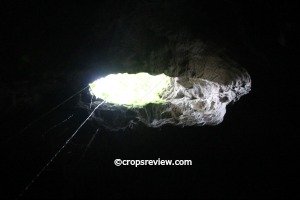The process of photosynthesis in plants consists of a complex series of biochemical reactions.
It converts CO2 into carbohydrates which involve the reduction of carbon with H2O as a reductant.
Reduction is a chemical reaction that results in the gain of electrons, a gain of hydrogen, or a loss of oxygen.
The reverse reaction is called oxidation which involves the removal of electrons from an atom, ion, or compound, or removal of hydrogen, or gain of oxygen.
The reduction of a substance also involves the oxidation of another, as in photosynthesis.
An overall summary of the process of photosynthesis is commonly represented by the chemical equation given below.
6CO2 + 6H2O + light energy → C6H12O6 + 6O2
or, without reference to glucose and to show the origins of oxygen in the carbohydrate and in the free oxygen,
CO2 + 2H2O+ light energy → (CH2O) + H2O + O2
The above reaction (modified from Mader 1993) indicates that carbohydrates (CH2O) are synthesized from CO2 and H2O in the presence of sunlight.
The colors also provide information on the origin of the constituents of the products.
It shows that both the carbon (in black) and oxygen (in red) in CH2O come from CO2 while the oxygen that is liberated (in blue) comes from water or H2O.
However, light energy is not utilized directly to drive the reaction. Similarly, H2O does not directly reduce CO2 to carbohydrate.
The process of photosenthesis in plants occurs inside the cell in highly structured organelles called chloroplast (a plastid).
Each chloroplast has a double membrane that surrounds a stroma.
The stroma is a large central space containing fluid rich in enzymes that reduce CO2 to CH2O.
Within the stroma are the grana.
Each granum consists of sack-like structures or disks called thylakoids which contain light-absorbing chlorophyll and yellow-orange pigments called carotenoid.
Chlorophyll is the green pigment that absorbs light during photosynthesis.
Chlorophyll a, the most important photosynthetic pigment, has the empirical formula C55H72O5N4Mg.
There are also accessory pigments that absorb photons of light that are not absorbed by chlorophyll a and transmit that energy to chlorophyll a.
The most common in plants are the chlorophyll b (C55H70O6N4Mg) and carotenoids (Moore et al. 2003).
The Process of Photosynthesis: Light and Dark Reactions
There are two component sets of reactions that occur sequentially: light reactions and dark reactions.
Light reactions are component reactions in the process of photosynthesis that occur in the thylakoids while the dark reactions, also called biochemical, light-independent, and Blackman’s reactions, occur in the stroma of the chloroplasts.
The Light Reactions of Photosynthesis
The light reactions of photosynthesis also called photochemical reactions and Hill reactions, are light-dependent reactions.
These reactions involve the capture of solar energy hence the term “light-dependent,” but are not sensitive to changes in temperature.
These constitute the first stage in the process of photosynthesis in which solar energy in the form of radiant energy is trapped and some are conserved in stable chemical form.
Two light-harvesting systems, or photosystems, are involved in the capture of light which is essential to the light reactions of photosynthesis.
Photosystem I (PS I) contains a reaction center chlorophyl (P700) and absorbs wavelengths of light up to 700 nm.
The second light-harvesting system, called photosystem 2 (PSII), has a reaction center called P680 and absorbs light up to 680 nm.
Once a photon of light is absorbed by any photosystem, it is funneled to the reaction center chlorophyll (PS700 or PS680) which is thus transformed into an excited state and becomes an excellent reducing agent.
The excited electron (from water) is then transferred to an electron transport chain.

Two substages are involved in the light-dependent process of photosynthesis.
The first is accomplished by the photosystem II, the second by the photosystem I (PS I is so denoted by “I”, the Roman numeral for one because it was the first to have been discovered).
First, H2O is oxidized to oxygen using the energy from sunlight that the chlorophyll captures.
This is also called photolysis of water or the splitting of the H20 molecule which yields excited electrons.
At the same time, the oxidizing agent NADP+ is reduced to NADPH, and oxygen is released to the atmosphere.
The photolysis of H2O occurs in photosystem II.
However, the electrons from water have not yet reached the NADPH. It is here that the photosystem I take charge.
2H2O + light energy → 4H + 4e- + O2
4e– + 2H+ + 2NADP+ → 2NADPH
These photochemical reactions are summarized in the following chemical equation:
2H2O + 2NADP+ → 2H+ + O2 + 2NADPH
Second, phosphorylation takes place leading to the formation of ATP.
This involves the capture of some part of the radiant energy by phosphorylating ADP to produce ATP.
H2O + ADP + Pi + NADP+ + light energy → O2 + ATP + NADPH + H+
The Dark Reactions of Photosynthesis
The dark reactions also called biochemical and Blackman’s reactions, are temperature-dependent but light-independent reactions in the process of photosynthesis.
The availability of light is not essential to these reactions which can occur either in the light or dark.
However, ATP, NADPH2, and CO2 must be present. These explain the reduction of fixed carbon dioxide to carbohydrates.
The summary equation is given below.
CO2 + ATP + NADPH + H+ → carbohydrates + ADP + Pi + NADP+
REFERENCES
DEVLIN R. 1975. Plant Physiology. 3rd ed. New York, NY: 600 p.
HOPKINS WG. 1999. Introduction to Plant Physiology. 2nd ed. New York, NY: John Wiley & Sons, Inc. 512 p.
MADER SS. 1993. Biology. Part 1: Biology of the Cell. 4th ed. Dubuque, IA: p. G-12.
MATHEWS CK, VAN HOLDE KE. 1990. Biochemistry. Redwood City, CA: The Benjamin/Cummings Publishing Company, Inc. 1129 p.
MOORE R, CLARK WD, VODOPICH DS. 2003. Botany. 2nd ed. Boston, Massachusetts: McGraw-Hill. 919 p.

